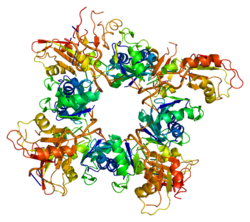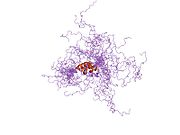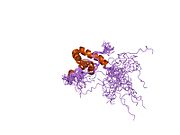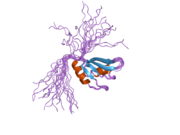Polyadenylate-binding protein 1 is a protein that in humans is encoded by the PABPC1 gene. The protein PABP1 binds mRNA and facilitates a variety of functions such as transport into and out of the nucleus, degradation, translation, and stability. There are two separate PABP1 proteins, one which is located in the nucleus (PABPN1) and the other which is found in the cytoplasm (PABPC1). The location of PABP1 affects the role of that protein and its function with RNA.
Function
The poly(A)-binding protein (PAB or PABP), which is found complexed to the 3' poly(A) tail of eukaryotic mRNA, is required for poly(A) lengthening and the termination of translation. In humans, the PABPs comprise a small nuclear isoform and a conserved gene family of other poly(A)-binding proteins.
PABPC1 is usually diffused within the cytoplasm and concentrated at sites of high mRNA concentration such as stress granules, processing bodies, and locations of high translational activity. PABPC1 is also associated with nonsense-mediated mRNA decay (NMD). PABPC1 binds to the poly(A) tail and interact with eIF4G, which stabilizes the circularization of mRNAs. This structure is required for the prevention of mRNA degradation via NMD.
In the nucleus PABP1 binds to the poly(A) tails of pre-mRNAs to facilitate stability, export, transport, and degradation. PABP1 binding is also required for nuclear-mediated degradation. PABPC1 contains four RNA-recognition motifs (RRMs). The first two, RRM1 and RRM2, bind both α-importin and the poly(A) tail of processed mRNA. This feature prevents mRNA from going back into the nucleus.
Interactions
PABPC1 has been shown to interact with:
References
- ^ GRCh38: Ensembl release 89: ENSG00000070756 – Ensembl, May 2017
- ^ GRCm38: Ensembl release 89: ENSMUSG00000022283 – Ensembl, May 2017
- "Human PubMed Reference:". National Center for Biotechnology Information, U.S. National Library of Medicine.
- "Mouse PubMed Reference:". National Center for Biotechnology Information, U.S. National Library of Medicine.
- Grange T, de Sa CM, Oddos J, Pictet R (June 1987). "Human mRNA polyadenylate binding protein: evolutionary conservation of a nucleic acid binding motif". Nucleic Acids Research. 15 (12): 4771–87. doi:10.1093/nar/15.12.4771. PMC 305917. PMID 2885805.
- ^ Gray NK, Hrabálková L, Scanlon JP, Smith RW (December 2015). "Poly(A)-binding proteins and mRNA localization: who rules the roost?". Biochemical Society Transactions. 43 (6): 1277–84. doi:10.1042/BST20150171. PMID 26614673.
- "Entrez Gene: PABPC1 poly(A) binding protein, cytoplasmic 1".
- Fatscher T, Boehm V, Weiche B, Gehring NH (October 2014). "The interaction of cytoplasmic poly(A)-binding protein with eukaryotic initiation factor 4G suppresses nonsense-mediated mRNA decay". RNA. 20 (10): 1579–92. doi:10.1261/rna.044933.114. PMC 4174440. PMID 25147240.
- Koloteva-Levine N, Pinchasi D, Pereman I, Zur A, Brandeis M, Elroy-Stein O (May 2004). "The Apc5 subunit of the anaphase-promoting complex/cyclosome interacts with poly(A) binding protein and represses internal ribosome entry site-mediated translation". Molecular and Cellular Biology. 24 (9): 3577–87. doi:10.1128/mcb.24.9.3577-3587.2004. PMC 387753. PMID 15082755.
- Funakoshi Y, Doi Y, Hosoda N, Uchida N, Osawa M, Shimada I, Tsujimoto M, Suzuki T, Katada T, Hoshino S (December 2007). "Mechanism of mRNA deadenylation: evidence for a molecular interplay between translation termination factor eRF3 and mRNA deadenylases". Genes & Development. 21 (23): 3135–48. doi:10.1101/gad.1597707. PMC 2081979. PMID 18056425.
- ^ Imataka H, Gradi A, Sonenberg N (December 1998). "A newly identified N-terminal amino acid sequence of human eIF4G binds poly(A)-binding protein and functions in poly(A)-dependent translation". The EMBO Journal. 17 (24): 7480–9. doi:10.1093/emboj/17.24.7480. PMC 1171091. PMID 9857202.
- Hoshino S, Imai M, Kobayashi T, Uchida N, Katada T (June 1999). "The eukaryotic polypeptide chain releasing factor (eRF3/GSPT) carrying the translation termination signal to the 3'-Poly(A) tail of mRNA. Direct association of erf3/GSPT with polyadenylate-binding protein". The Journal of Biological Chemistry. 274 (24): 16677–80. doi:10.1074/jbc.274.24.16677. PMID 10358005.
- Roy G, De Crescenzo G, Khaleghpour K, Kahvejian A, O'Connor-McCourt M, Sonenberg N (June 2002). "Paip1 interacts with poly(A) binding protein through two independent binding motifs". Molecular and Cellular Biology. 22 (11): 3769–82. doi:10.1128/mcb.22.11.3769-3782.2002. PMC 133836. PMID 11997512.
- Craig AW, Haghighat A, Yu AT, Sonenberg N (April 1998). "Interaction of polyadenylate-binding protein with the eIF4G homologue PAIP enhances translation". Nature. 392 (6675): 520–3. Bibcode:1998Natur.392..520C. doi:10.1038/33198. PMID 9548260. S2CID 10891925.
- Khaleghpour K, Kahvejian A, De Crescenzo G, Roy G, Svitkin YV, Imataka H, O'Connor-McCourt M, Sonenberg N (August 2001). "Dual interactions of the translational repressor Paip2 with poly(A) binding protein". Molecular and Cellular Biology. 21 (15): 5200–13. doi:10.1128/MCB.21.15.5200-5213.2001. PMC 87244. PMID 11438674.
Further reading
- Görlach M, Burd CG, Dreyfuss G (April 1994). "The mRNA poly(A)-binding protein: localization, abundance, and RNA-binding specificity". Experimental Cell Research. 211 (2): 400–7. doi:10.1006/excr.1994.1104. PMID 7908267.
- Campbell LH, Borg KT, Haines JK, Moon RT, Schoenberg DR, Arrigo SJ (September 1994). "Human immunodeficiency virus type 1 Rev is required in vivo for binding of poly(A)-binding protein to Rev-dependent RNAs". Journal of Virology. 68 (9): 5433–8. doi:10.1128/jvi.68.9.5433-5438.1994. PMC 236943. PMID 8057425.
- Huang Y, Carmichael GG (April 1996). "Role of polyadenylation in nucleocytoplasmic transport of mRNA". Molecular and Cellular Biology. 16 (4): 1534–42. doi:10.1128/mcb.16.4.1534. PMC 231138. PMID 8657127.
- Craig AW, Haghighat A, Yu AT, Sonenberg N (April 1998). "Interaction of polyadenylate-binding protein with the eIF4G homologue PAIP enhances translation". Nature. 392 (6675): 520–3. Bibcode:1998Natur.392..520C. doi:10.1038/33198. PMID 9548260. S2CID 10891925.
- Afonina E, Stauber R, Pavlakis GN (May 1998). "The human poly(A)-binding protein 1 shuttles between the nucleus and the cytoplasm". The Journal of Biological Chemistry. 273 (21): 13015–21. doi:10.1074/jbc.273.21.13015. PMID 9582337.
- Imataka H, Gradi A, Sonenberg N (December 1998). "A newly identified N-terminal amino acid sequence of human eIF4G binds poly(A)-binding protein and functions in poly(A)-dependent translation". The EMBO Journal. 17 (24): 7480–9. doi:10.1093/emboj/17.24.7480. PMC 1171091. PMID 9857202.
- Hornstein E, Git A, Braunstein I, Avni D, Meyuhas O (January 1999). "The expression of poly(A)-binding protein gene is translationally regulated in a growth-dependent fashion through a 5'-terminal oligopyrimidine tract motif". The Journal of Biological Chemistry. 274 (3): 1708–14. doi:10.1074/jbc.274.3.1708. PMID 9880551.
- Laroia G, Cuesta R, Brewer G, Schneider RJ (April 1999). "Control of mRNA decay by heat shock-ubiquitin-proteasome pathway". Science. 284 (5413): 499–502. Bibcode:1999Sci...284..499L. doi:10.1126/science.284.5413.499. PMID 10205060.
- Hoshino S, Imai M, Kobayashi T, Uchida N, Katada T (June 1999). "The eukaryotic polypeptide chain releasing factor (eRF3/GSPT) carrying the translation termination signal to the 3'-Poly(A) tail of mRNA. Direct association of erf3/GSPT with polyadenylate-binding protein". The Journal of Biological Chemistry. 274 (24): 16677–80. doi:10.1074/jbc.274.24.16677. PMID 10358005.
- Deo RC, Bonanno JB, Sonenberg N, Burley SK (September 1999). "Recognition of polyadenylate RNA by the poly(A)-binding protein". Cell. 98 (6): 835–45. doi:10.1016/S0092-8674(00)81517-2. PMID 10499800. S2CID 16247357.
- Féral C, Mattéi MG, Pawlak A, Guellaën G (October 1999). "Chromosomal localization of three human poly(A)-binding protein genes and four related pseudogenes". Human Genetics. 105 (4): 347–53. doi:10.1007/s004399900148. PMC 1865476. PMID 10543404.
- Grosset C, Chen CY, Xu N, Sonenberg N, Jacquemin-Sablon H, Shyu AB (September 2000). "A mechanism for translationally coupled mRNA turnover: interaction between the poly(A) tail and a c-fos RNA coding determinant via a protein complex". Cell. 103 (1): 29–40. doi:10.1016/S0092-8674(00)00102-1. PMID 11051545. S2CID 18135412.
- Khaleghpour K, Svitkin YV, Craig AW, DeMaria CT, Deo RC, Burley SK, Sonenberg N (January 2001). "Translational repression by a novel partner of human poly(A) binding protein, Paip2". Molecular Cell. 7 (1): 205–16. doi:10.1016/S1097-2765(01)00168-X. PMID 11172725.
- Bushell M, Wood W, Carpenter G, Pain VM, Morley SJ, Clemens MJ (June 2001). "Disruption of the interaction of mammalian protein synthesis eukaryotic initiation factor 4B with the poly(A)-binding protein by caspase- and viral protease-mediated cleavages". The Journal of Biological Chemistry. 276 (26): 23922–8. doi:10.1074/jbc.M100384200. PMID 11274152.
- Féral C, Guellaën G, Pawlak A (May 2001). "Human testis expresses a specific poly(A)-binding protein". Nucleic Acids Research. 29 (9): 1872–83. doi:10.1093/nar/29.9.1872. PMC 37253. PMID 11328870.
- Khaleghpour K, Kahvejian A, De Crescenzo G, Roy G, Svitkin YV, Imataka H, O'Connor-McCourt M, Sonenberg N (August 2001). "Dual interactions of the translational repressor Paip2 with poly(A) binding protein". Molecular and Cellular Biology. 21 (15): 5200–13. doi:10.1128/MCB.21.15.5200-5213.2001. PMC 87244. PMID 11438674.
- Woods AJ, Roberts MS, Choudhary J, Barry ST, Mazaki Y, Sabe H, Morley SJ, Critchley DR, Norman JC (February 2002). "Paxillin associates with poly(A)-binding protein 1 at the dense endoplasmic reticulum and the leading edge of migrating cells". The Journal of Biological Chemistry. 277 (8): 6428–37. doi:10.1074/jbc.M109446200. PMID 11704675.
- Lee J, Bedford MT (March 2002). "PABP1 identified as an arginine methyltransferase substrate using high-density protein arrays". EMBO Reports. 3 (3): 268–73. doi:10.1093/embo-reports/kvf052. PMC 1084016. PMID 11850402.
- Jurica MS, Licklider LJ, Gygi SR, Grigorieff N, Moore MJ (April 2002). "Purification and characterization of native spliceosomes suitable for three-dimensional structural analysis". RNA. 8 (4): 426–39. doi:10.1017/S1355838202021088. PMC 1370266. PMID 11991638.
| PDB gallery | |
|---|---|
|
| RNA-binding proteins | |
|---|---|
|









